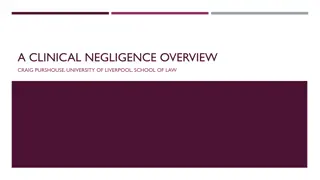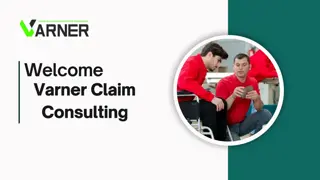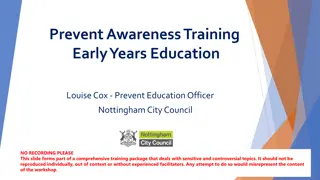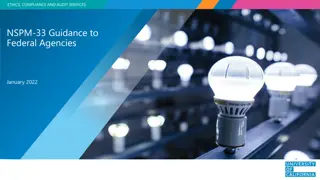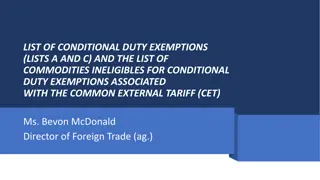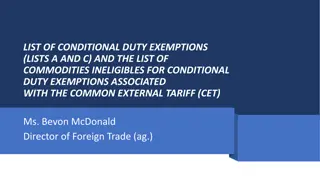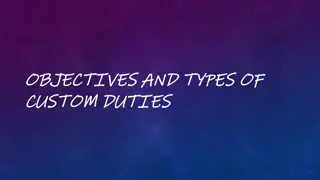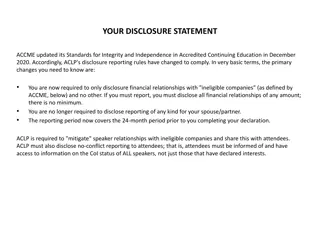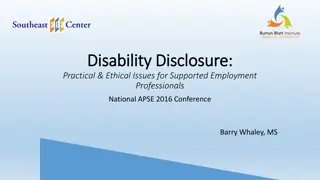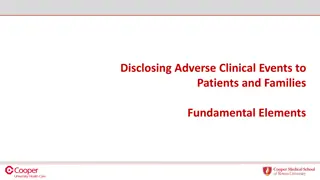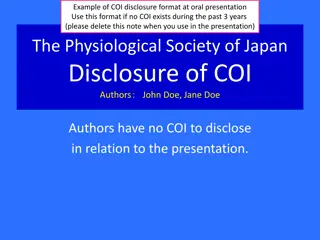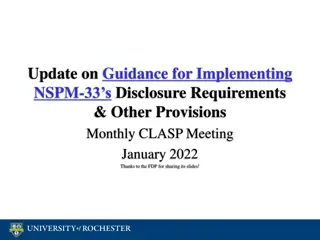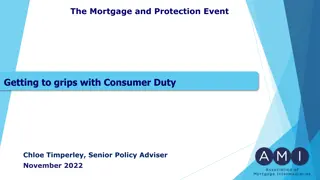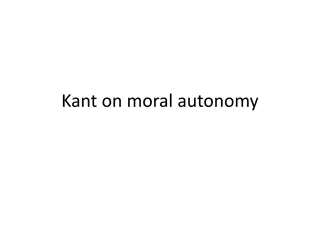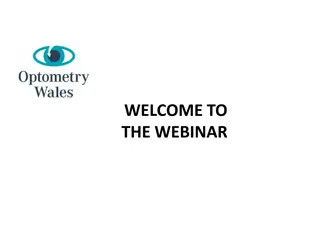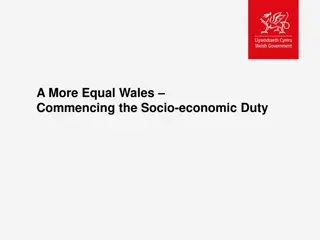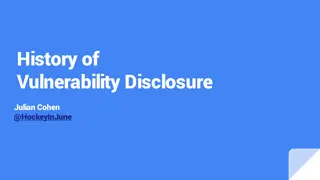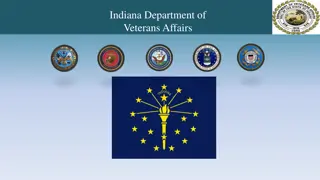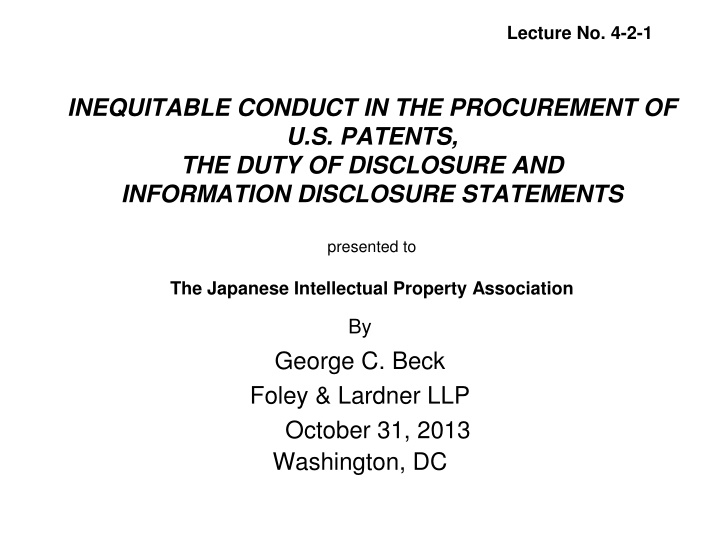
Inequitable Conduct in U.S. Patent Procurement
Explore the intricacies of inequitable conduct in U.S. patent acquisition, including the duty of disclosure and information disclosure statements. Learn about the elements of inequitable conduct, materiality standards, and the importance of intent knowledge in patent procurement.
Download Presentation

Please find below an Image/Link to download the presentation.
The content on the website is provided AS IS for your information and personal use only. It may not be sold, licensed, or shared on other websites without obtaining consent from the author. If you encounter any issues during the download, it is possible that the publisher has removed the file from their server.
You are allowed to download the files provided on this website for personal or commercial use, subject to the condition that they are used lawfully. All files are the property of their respective owners.
The content on the website is provided AS IS for your information and personal use only. It may not be sold, licensed, or shared on other websites without obtaining consent from the author.
E N D
Presentation Transcript
Lecture No. 4-2-1 INEQUITABLE CONDUCT IN THE PROCUREMENT OF U.S. PATENTS, THE DUTY OF DISCLOSURE AND INFORMATION DISCLOSURE STATEMENTS presented to The Japanese Intellectual Property Association By George C. Beck Foley & Lardner LLP October 31, 2013 Washington, DC
Overview I. II. III. Information Disclosure Statements IV. Questions and Answers The Doctrine of Inequitable Conduct The Duty of Disclosure and PTO Rules Foley & Lardner LLP
Congratulations Red Sox! Foley & Lardner LLP
I. Doctrine of Inequitable Conduct
Elements of Inequitable Conduct 1. the information must be material and 2. the breach must have occurred with intent to mislead. Therasense: significantly limits applicability: Each must be shown by clear and convincing evidence Materiality must meet but for test. Only exception is egregious misconduct Foley & Lardner LLP
Materiality: Standards Current Standard -applies to applications filed after March 16, 1992 -defined by PTO Rule 56 Prior Standard -applies to applications filed prior to March 16, 1992 - reasonable examiner standard Foley & Lardner LLP
Current Materiality Standard under Rule 56 Information NOT cumulative; and (1) Establishes, by itself or in combination with other information, prima facie unpatentability or (2) Refutes or is inconsistent with a position applicant takes: (a) opposing an argument of unpatentability by PTO; or (b) asserting an argument of patentability Foley & Lardner LLP
Intent Knowledge of: falsity of misrepresentation or an obligation to know it Proven by: direct evidence of intent to mislead inferred by facts showing knowing failure to disclose or acts which have natural consequence to deceive BUT: the inference must be the only reasonable inference. See Therasense. Foley & Lardner LLP
Intent Gross Negligence does not of itself justify an inference of intent to deceive - See Kingsdown Medical Consultants Ltd. v. Hollister Inc. (Fed. Cir. 1988) (finding no deceptive intent, despite the grossly negligent conduct of the patent attorney). Ignorance of obligation may weigh against finding of intent -But see Nilssenn v. Osram Sylvania, Inc. (Fed. Cir. 2007) (affirming inequitable conduct by pro se defendant improper small entity payments, incorrect priority claim, failure to disclose parallel litigation). Foley & Lardner LLP
Effects of Inequitable Conduct Entire patent rendered unenforceable. May result in infectious unenforceability . May give rise to antitrust claim. May give rise to payment of costs and attorneys fees under 35 USC 285. May result in disciplinary action against agent or attorney. Foley & Lardner LLP
Pleading Inequitable Conduct Must be pled with particularity under Fed. R. Civ. P. 9(b). Must include sufficient allegations of underlying facts from which a court may reasonably infer that a specific individual (1) knew of the withheld material information or of the falsity of the material representation, and (2) withheld or misrepresented this information with a specific intent to deceive the PTO. Must identify the specific who, what, when, where, and how of the material representation or omission committed before the PTO. -See Exergen Corp. v. Wal-Mart Stores, Inc., (Fed Cir. 2009) (affirming denial of defendant s motion to amend due to insufficiency of pleadings). Foley & Lardner LLP
Curing Potential Failure To Comply With Duty of Disclosure During Pendency of Application: 1. Non-disclosure: cite information 2. Incorrect/false statement: 1. Advise PTO of existence of misrepresentation 2. Advise PTO of actual facts. 3. Establish patentability in view of correct facts. After patent issues: Supplemental Examination (AIA) Effective: 9/16/2012 May have up to 12 items of information considered Fee: $16,500 for large entity Effect: Within 3 months Office will determine if there is substantial new question of patentability: if SNQ, PTO will initiate ex parte reexamination If no SNQ, receive a certificate of supplemental examination Provides a complete defense against inequitable conduct PROVIDED request is filed before an allegation of inequitable conduct raised in lawsuit. Foley & Lardner LLP
II. Duty of Disclosure: PTO Rules 56 and 105
II. Rule 56 imposes duty of candor Duty of candor applies to all individuals substantively involved in preparation and prosecution of application: inventor; patent drafter(s); agents/attorneys directing prosecution; technical personnel involved with prosecution. Foley & Lardner LLP
Prior Art Subject to Disclosure under Rule 56 Prior art, e.g., (a) uncovered in patentability search (b) cited in non-US counterpart application; (c) closest information known over which claims define a patentable invention Prior art may include: publications, patents, presentations, disclosures in US, offers for sale in US, undisclosed invention by others Foley & Lardner LLP
Other information covered by Rule 56 Commonly owned/co-pending applications -SeeMcKesson Information Solutions, Inc. v. Bridge Medical, Inc., (Fed. Cir. 2007) (affirming unenforceability on the basis of inequitable conduct involving nondisclosure of copending application information); Dayco Prods. Inc. v. Total Containment, Inc., (Fed. Cir. 2003) (finding undisclosed copending applications with substantially similar claims were material under Rule 56) False or misleading information in declaration Material information omitted from declaration Concealment of best mode False statements in support of petition to make special Inaccurate claim to small entity status Foley & Lardner LLP
Information that needs not be disclosed (or corrected) Cumulative information Details prosecution of non-US prosecution Mistaken arguments in support of patentability (provided examiner in position to make correct determination on record) Information from parent application. See ADT Corp. v. Lydall (Fed. Cir. 1998) Foley & Lardner LLP
Rule 105 Only required to provide information under Rule 105 if requested by examiner May be required of inventor or assignee. Failure to respond may result in finding that reply is non-responsive. Foley & Lardner LLP
Rule 105: examples of information that may be requested Information may extend beyond scope of Rule 56, including: (1) commercial databases known to applicant, (2) whether prior art search conducted and scope thereof, (3) information relating to invention, (4) information used to draft the application, (5) information used in invention process, (6) what device/method invention improves on, (7) details of any use of invention, (8) technical information regarding subject matter of application. Foley & Lardner LLP
III. Information Disclosure Statements: Rules 97 and 98
Timing of IDS Within 3 months of filing No fee; must be considered. Before mailing of first action No fee; must be considered. After first action Requires statement or fee After allowance or final action, but before payment of issue fee After payment of issue fee Requires statement, fee and petition. Not considered. After patent issues Not required. Foley & Lardner LLP
Content of IDS Identification of document with dates (or if application, serial number and filing date) Copies of documents (except US patents and published applications) Any readily available English translation Concise explanation of relevance of non- English documents. Fee and/or statement if later more than 3 months from filing date and after first action Foley & Lardner LLP
Proprietary IDS No exception in Rule 56 for trade secret/confidential information. Can submit proprietary IDS . MPEP 724.02. If information not important to the decision on patentability, applicant may file petition to expunge. If information deemed important to deciding patentability, will remain in file. Foley & Lardner LLP
Quick Path IDS Pilot program enabling consideration of information submitted: After payment of IDS Before issuance of patent Requires: 1. Transmittal form 2. IDS with timeliness statement and fee 3. ePetition to Withdraw from Issue after Payment of Issue Fee 4. RCE and fee 1. RCE is considered conditional : will only be processed if the examiner determines that information necessitates reopening prosecution Effect/Result: Either corrected Notice of Allowance or reopened prosecution in RCE Foley & Lardner LLP
Question 1 When must a concise explanation of relevance of a document be provided in an IDS? Answer: A concise explanation of relevance is required when a document is not in the English language. 37 CFR 1.97(a)(3)(i). Foley & Lardner LLP
Question 2 An application has just been allowed and the issue fee is due in two months. The inventor comes to you and tells you that he has a copy of some very close prior art which has not been disclosed to the U.S. PTO. The inventor has known about the prior art for 2 years. What do you have to do to have the prior art considered? Answer: Because the application is allowed, an IDS would require (1) a statement pursuant to 37 CFR 1.97(e); (2) fee required by 37 CFR 1.17(p). Because the inventor knew abou the prior art for 2 years, it is not possible to make the Rule 97(e) statement. In order to require consideration by the Examiner, it would be necessary file an RCE. Foley & Lardner LLP
Question 3 You are preparing to file an application in the U.S. PTO for an invention. Two years ago the invention was displayed to a potential customer in the United States. After some investigation, you conclude that the display was probably not a public use . However, because the public use law is not entirely clear, you are not sure whether the display is prior art. Should you disclose information relating to the display to the U.S. PTO? Answer: If the information was clearly not a public use, the information is not material. If there is uncertainty, however, it would be preferable to disclose the information regarding the display so that circumstances of the display may be considered by the examiner. If the information is proprietary, it may be possible to submit a proprietary IDS. Foley & Lardner LLP
Question 4 You are preparing a new US patent application. You want to include five different embodiments in the application. For four of the embodiments you have actual test data which demonstrates unexpected results. For the last embodiment you do not have actual test data, however you have a good idea of what the test data should be for the last embodiment. A colleague suggests that data for all five embodiments be included in the application and be presented in a form which suggests that the data for all five embodiments is actual test data in order for the application to be viewed positively by the examiner. Do you have any inequitable conduct concerns? Answer: Yes. It is acceptable to include fifth embodiment, but the specification should be clear that it the test was not actually performed. Foley & Lardner LLP
Question 5 You are working on a very important patent application. There is one piece of prior art which is much closer than all of the other prior art that you know about. This one piece is a technical journal article in Japanese. Colleague A suggests that in order to satisfy the requirement for a concise explanation of relevance you submit a few comments on the prior art explaining how the prior art is similar to your invention and how the prior art is different from your invention. Is Colleague A s suggestion the best way of satisfying your duty of disclosure requirements? Answer: This may be acceptable, but care needs to be exercised that the explanation is complete as to all potentially relevant aspects of the prior art reference to avoid an allegation that material information was withheld. Foley & Lardner LLP
Question 6 You are working on an application for a medical device and plan to file the application in the US next month. The medical device has been used in clinical trials in the US for the last two years. You consider the clinical trials to be within the experimental use exception and therefore not prior art. Should you disclose any information about the clinical trials to the USPTO? Answer: This would require a detailed consideration of the specific factual circumstances. In some cases, information relating to the clinical trials may be material to patentability and require disclosure. One option may be to consider disclosing the information in a proprietary IDS. Foley & Lardner LLP
Question 7 In response to a section 112, first paragraph, rejection for lack of enablement, you are preparing a 132 declaration by a university professor. The university professor is well known in the field and has acted as a consultant to your company. Are there any inequitable conduct concerns regarding the declaration? Answer: The professor s consulting relationship should be disclosed. This relationship may impact the weight the examiner would give the declaration. Foley & Lardner LLP
Question 8 You are reviewing a notice of allowance for an application and notice that the USPTO has indicated that you have 375 days of patent term adjustment. You think that you are entitled to 240 days of adjustment. Should you tell the PTO that they made a mistake? Answer: Yes, it is advisable to inform the PTO that its calculation differs from Applicant s. Foley & Lardner LLP
Question 9 A US application has been allowed and is scheduled to issue next week. You just received a European search report for the corresponding EPO application and review the documents cited therein. While the documents are relevant to the invention, you have good arguments that your claims are patentable over the documents. What should you do? Answer: Although there are good arguments that the claims are patentable, it would be preferable to have the information considered. To have the information considered, Applicant may file an RCE and a petition to withdraw pursuant to 37 CFR 1.313. Under current PTO procedures, a Quick Path IDS may be available because Applicant could certify as to timeliness pursuant to 37 CFR 1.97(d)(1) and (e)(1). Foley & Lardner LLP
Question 10 A US application has been allowed and is scheduled to issue next week. Upon reviewing your file, you find a European search report for the corresponding EPO application. The search report was received by you a year ago and you simply forgot to cite the documents cited therein to the USPTO. You review the documents. While the documents are relevant to the invention, you have good arguments that your claims are patentable over the documents. What should you do? Answer: Although there are good arguments that the claims are patentable, it would be preferable to have the information considered. To have the information considered, Applicant may file an RCE and a petition to withdraw pursuant to 37 CFR 1.313. Note: under current PTO procedures, a Quick Path IDS would not be available because Applicant could not certify as to timeliness pursuant to 37 CFR 1.97(d)(1). There would be some risk that the PTO would not grant the petition before issuance. Foley & Lardner LLP
Question 11 A US examiner has refused to consider a Japanese language document because you did not provide a concise explanation of relevance. The examiner tells you that, although the document is discussed in the patent application you are handling, a concise explanation must be in the IDS. Is the examiner correct? Answer: No, the Examiner is incorrect. 37 CFR 1.98(a)(3)(i). Foley & Lardner LLP
Question 12 A US patent has just issued to your company. Two days after the patent issued, you receive an EPO search report, for the related EPO case, citing very close prior art (Category X and Y documents). Do you have to disclose the documents to the USPTO? Answer: No. The patent already issued. Foley & Lardner LLP
Question 13 You receive an EPO search report which cites two US patents. These US patents have been considered by the US examiner because they were cited in a prior IDS. Should the EPO search report be disclosed to the US examiner? Answer: There is no requirement to do so. The patents were in English and already considered by the US examiner. Foley & Lardner LLP
Thank You! Additional questions? Feel free to contact: George Beck 202-945-6014 gbeck@foley.com Foley & Lardner LLP

